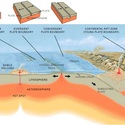A nervous laugh often accompanies the statement, “Our house is on the fault line” We all know that it is not a great place to be during an earthquake, but what actually is a fault line?
Cracks or fractures in the Earth’s crust are known as faults, and because there may be more than one rock fracture, an area of related cracks is called a fault line. This might be an inactive fault where scientists can see where past movement has been or one that continues to be active even after millions of years. All but the very deepest earthquakes occur on faults. Faults might be only metres or up to a thousand kilometres long.
A fault is a three-dimensional structure located between two blocks of crust. The two surfaces of these two blocks moving past each other form what is called the fault plane. Not all faults reach the ground surface – they may be hidden from sight but can be detected using instruments such as seismographs. When a fault does reach the ground surface, we can often see evidence in the form of ridges, steps or gaps. This visible part of a fault is called the fault trace
When tectonic plates move, the rocks at the junction between the two plates are not able to simply glide past each other, due to friction and the rigidity of the rock. Instead, stress builds up in the rock until eventually it breaks, and the two rocky blocks move relative to each other along a fault line.
Faults are categorised into three groups
Normal fault – the blocks of earth are pulled apart and follow normal gravitational pull, and one block slips downwards. The exposed upward block forms a cliff known as a fault scarp.
Reverse (or thrust) fault – the fault blocks move towards each other. In reverse to the normal fault, one block rides up to overlap the other.
Strike slip fault – the blocks shift past each other in a horizontal movement. An example is the San Andreas Fault in California – almost 960 km long – on the margin of the Pacific plate and the North American plate. During the 1906 earthquake that destroyed the city of San Francisco, the fault moved 6 metres.
Most faults are a combination of fault types.
Nature of science
Scientists' predictions are based on their existing science knowledge. By examining fault lines, scientists are able to predict where earthquakes are likely to occur and the likelihood of when they might occur.
What about Wellington?
Wellington is located on six active fault lines – many are a combination of reverse and strike slip faults. As with any coastal settlement, there is also a threat of tsunamis, which can be caused by vertical fault movement under the ocean.
Geologists study a fault trace to build up a history of its movement and work out the timing between each movement. The probability that a fault within 40 km of Wellington will break within the next 50 years is estimated at 40–45%.
Related content
In 2013 a magnitude 6.5 earthquake shook Wellington and the top of the South Island, causing minor damage.
The 2016 Mw 7.8 Kaikōura earthquake was a complex sequence of ruptures that included 12 major faults and nine lesser faults. Experts believe this may be a world record for the number of faults rupturing during a single earthquake.
The plate tectonics theory explains that the Earth’s outer layer is divided into oceanic and continental plates that slide over the layer below – this movement is responsible for geologic activity such as earthquakes.
Explore some of the research being undertaken on The Alpine Fault in the South Island – an on-land boundary between two tectonic plates.
Useful links
Find out more about New Zealand's faults from GNS here.
Read this press release to learn about research from NIWA on a newly discovered fault line in Wellington.
In these Radio NZ Our Changing World programmes from 2022 explore the research of scientists Digging into the past of sleeping giant faults and Finding faults and eavesdropping on earthquakes in Aotearoa New Zealand.







